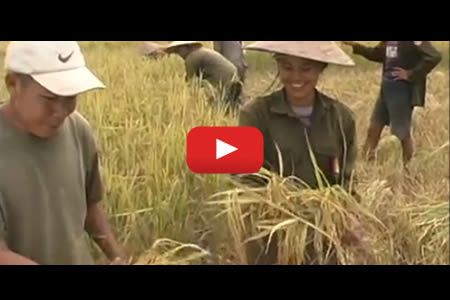Carbonization of rice husk
Biochar production and utilization
Biochar, a carbon-rich product, is produced through thermal decomposition of organic material or biomass under a limited supply of oxygen (O2), and at relatively low temperatures (less than 700°C) in a process known as carbonization. The carbonization process for organic material at 1MPa can be represented by the following Equation (Eq. 1) introduced by Antal and Gronli (2003).
C6H10O5 è 3.74C + 2.65H2O + 1.17CO2 + 1.08CH4 (Eq 1)
Based on this research, biochar yield decreases as peak temperature increases, whereas increasing peak temperature leads to an increase in fixed carbon yield. In another study of Azhar Uddin and Ho Thi Phuong (2009) on carbonization of rice husk and rice straw, carbon content increased from 48 to 51% and 53 to 58% with increase in temperature from 350 to 550°C, respectively, and a heating rate of 10°C per minute. Biochar yield and quality are also affected by pressure and heating rate (Mochidzuki et al 2002, Manya et al 2013).
Biochar is used as soil amendment to improve soil productivity, carbon storage, and filtration of percolating soil water (Lehmann and Joseph 2009). Libra et al (2011) have found it to have beneficial effects in increasing water-holding capacity, aeration and hydraulic conductivity, reduced tensile strength of hard-setting soils, and stimulating growth activity. A study of Haefele et al (2011) showed that application of untreated and carbonized rice husks increased total organic carbon, total soil N, C:N ratio, and available P and K, whereas high C:N ratio of carbonized rice husk (biochar) limits N availability, thereby slightly reducing grain yield. On a poor soil, which is identified as having low organic carbon, nitrogen content, base saturation, K availability, and cation exchange capacity; and dominated by sand, soil chemical and physical improvements increased yields by 16–35% with an amendment of 4.13 kg carbonized rice husk per square meter croping. On the other hand, biochar processing needs to be considered with respect to energy balance and production and application cost. Using biochar as soil amendment, instead of burning the fuel more completely, reduces the energy efficiency of bioenergy production. However, carbon sequestration in biochar production helps mitigate climate change (Dominic et al 2010 ) and the emission reductions associated with addition of biochar to the soil appear to be greater than the fossil fuel offset in its use as fuel (Gaunt and Lehmann 2008).
An advance carbonization technology has been developed recently, which is called hydrothermal carbonization (HTC). The HTC of lignocellulosic biomass is a process that completely breaks down the plant cell wall and allows rapid conversion of biomass into a carbon-rich and lignite-like product (hydrochar). The carbonized product is composed of water-soluble compounds and solid residues. The aqueous phase contains sugar and lignin-derived compounds, which may be desirable feedstock for biodiesel and chemical production. The resulting solid products consist mainly of lignin with a high degree of aromatization and a large amount of oxygen-containing groups. Moreover, the hydrochar had a considerably higher heating value than the raw material (Ling-Ping Xiao et al 2012). Compared with biochar, hydrochar is not yet applied as a soil amendment. This process requires much water (Libra et al 2011) when used as soil amendment.
References
Antal MJ, Gronli M. 2003. Science and Technology of Charcoal Production. Ind. Eng. Chem. Res. 42:1619-1640.
Gaunt JL, Lehmann J. 2008. Energy Balance and Emissions Associated with Biochar Sequestration and Pyrolysis Bioenergy Production. Environ. Sci. Technol. 42(11):4152–4158.
Haefele SM, Konboon Y, Wongboon W, Amarante S, Maarifat AA, Pfeiffer EM, Knoblauch C. 2011. Effects and fate of biochar from rice residues in rice-based systems. Field Crops Res. 121(3):430-440.
Lehmann J, Joseph S. 2009. Biochar for Environmental Management: An Introduction. In: Biochar for Environmental Management. p 1–12.
Libra JA, Ro KS, Kammannn C, Funke A, Berge ND, Neubauer Y. 2011. Hydrothermal carbonization of biomass residuals: A comparative review of chemistry, processes and applications of wet and dry pyrolysis. Biofuels 2(1):71-106.
Ling-Ping Xiao, Zheng-Jun Shi, Feng Xu, Run-Cang Sun. 2012. Hydrothermal carbonization of lignocellulosic biomass. Bioresource Technol. 118:619–623.
Manya JJ, Roca FX, Perales JF. 2013. TGA study examining the effect of pressure and peak temperature on biochar yield during pyrolysis of two-phase olive mill waste. J. Anal. Appl. Pyrolysis 103:86-95.
Md. Azhar Uddin, Ho Thi Phuong. 2009. Development of Technologies for the Utilization of Agricultural and Forestry Wastes: Preparation of Biochar from Rice Residues. Okayama University. 3-1-1 Tsushima Naka, Kita-ku, Okayama 700-8530, Japan.
Mochidzuki K, Paredes LS, Antal MJ. AIChE. 2002. Reactor Engineering for Biomass Feedstocks. Annual Meeting, Indianapolis, November 3-8.
Woolf D, Amonette JE, Street-Perrott FA, Lehmann J, Joseph S. 2010. Sustainable biochar to mitigate global climate change. Nat. Commun. 1(5):1–9.







